Thomas James Richards, Diaries, Transcript Vol. 4, 9 November 1916 - 31 May 1918 - Part 30
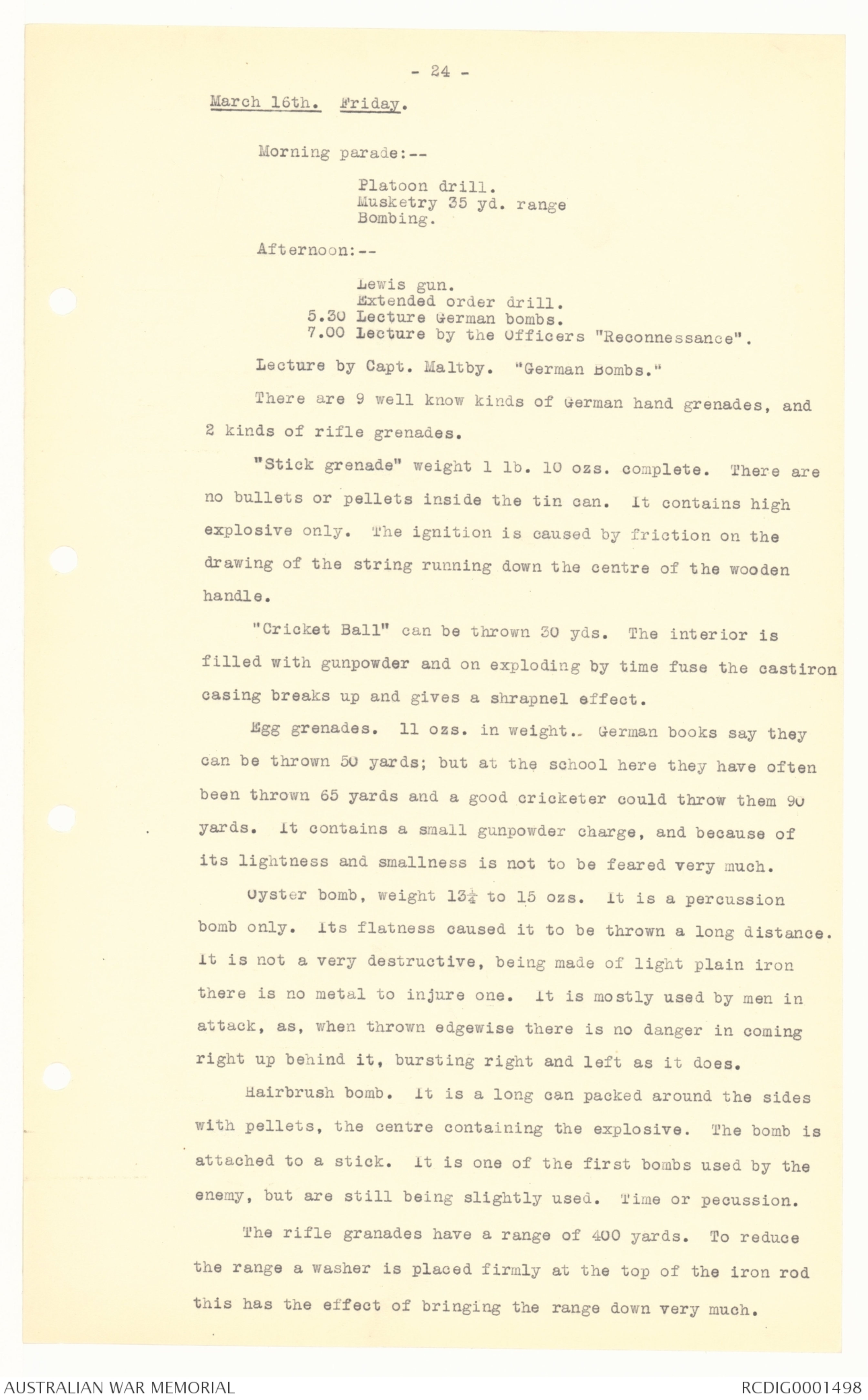
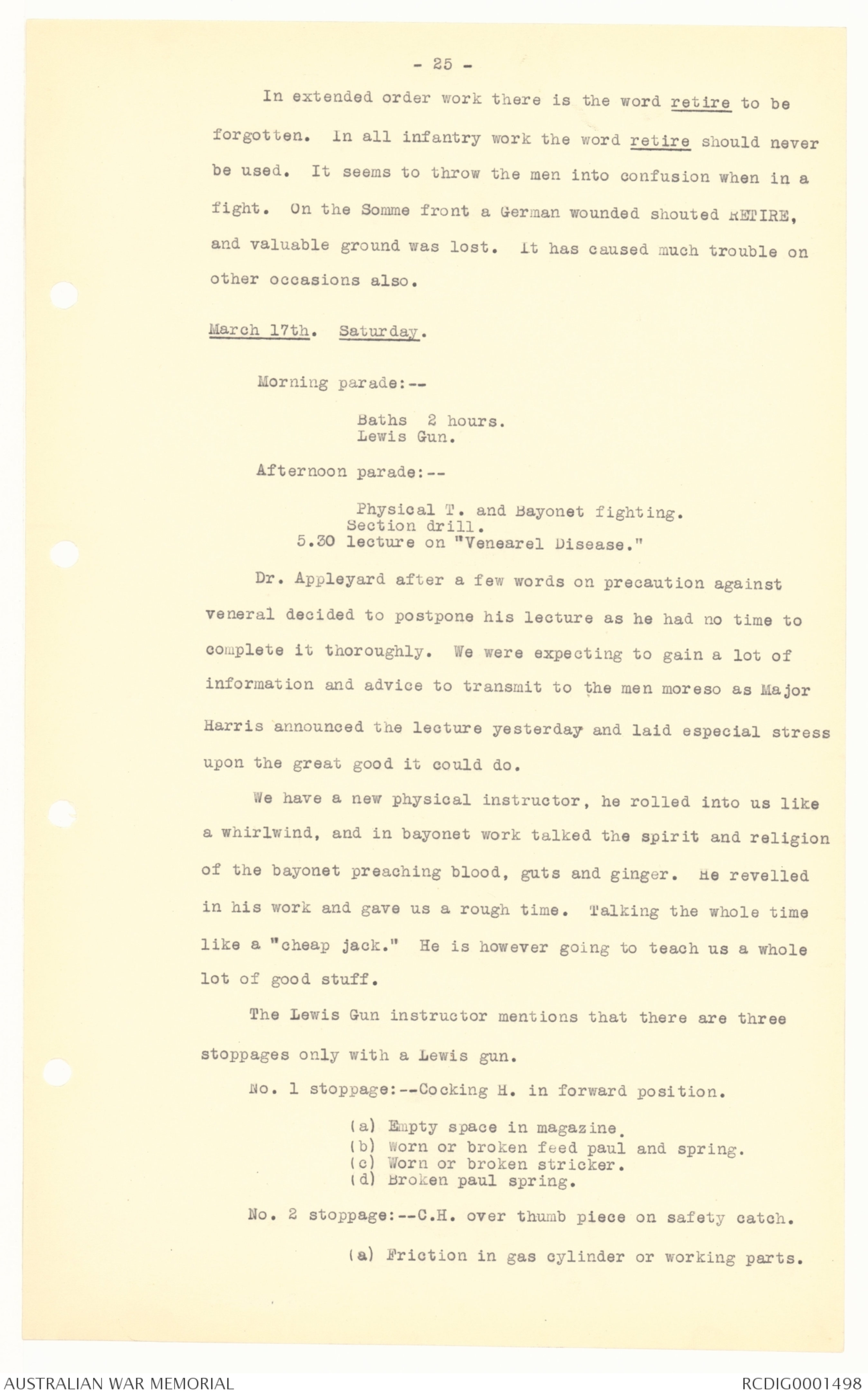


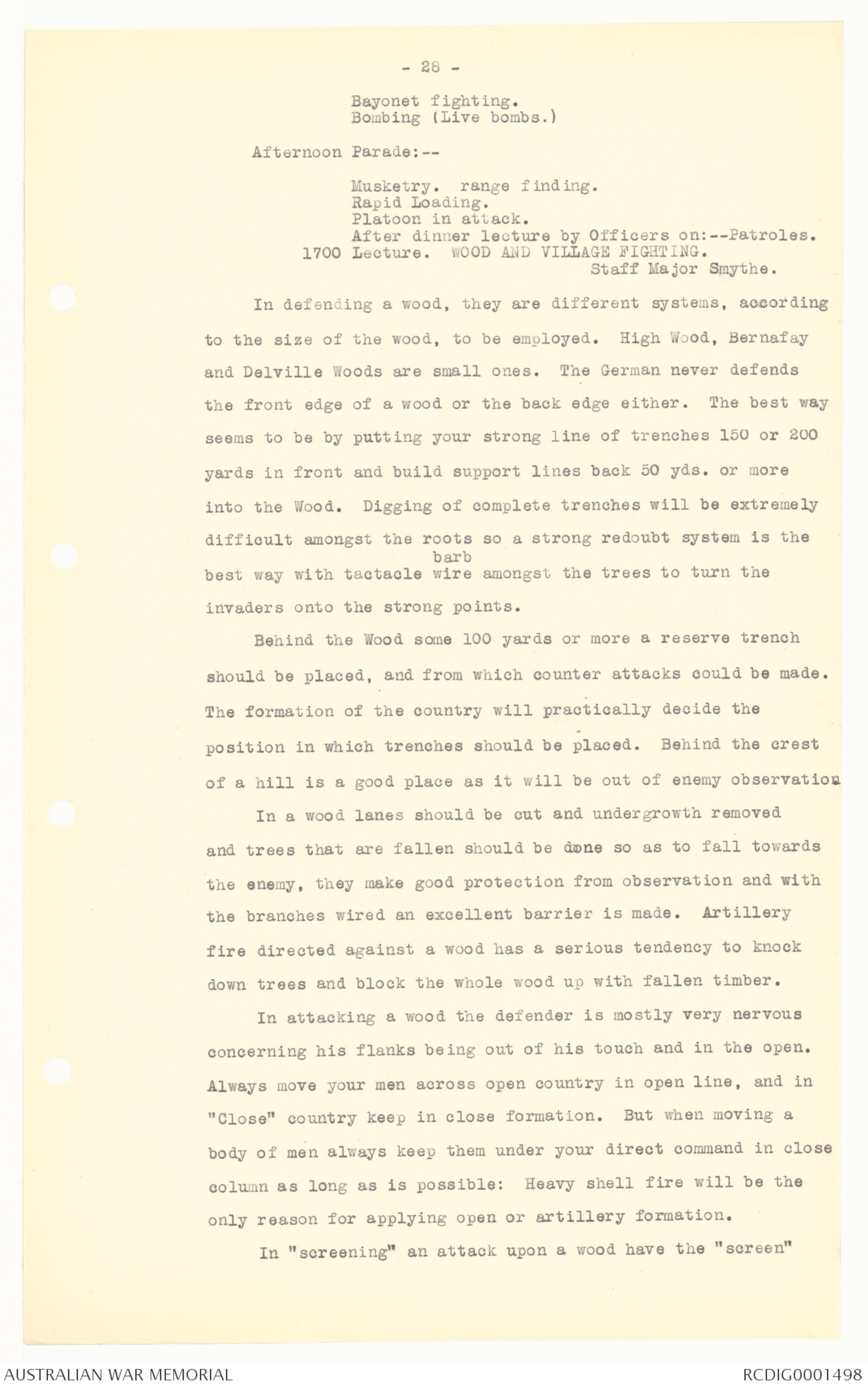

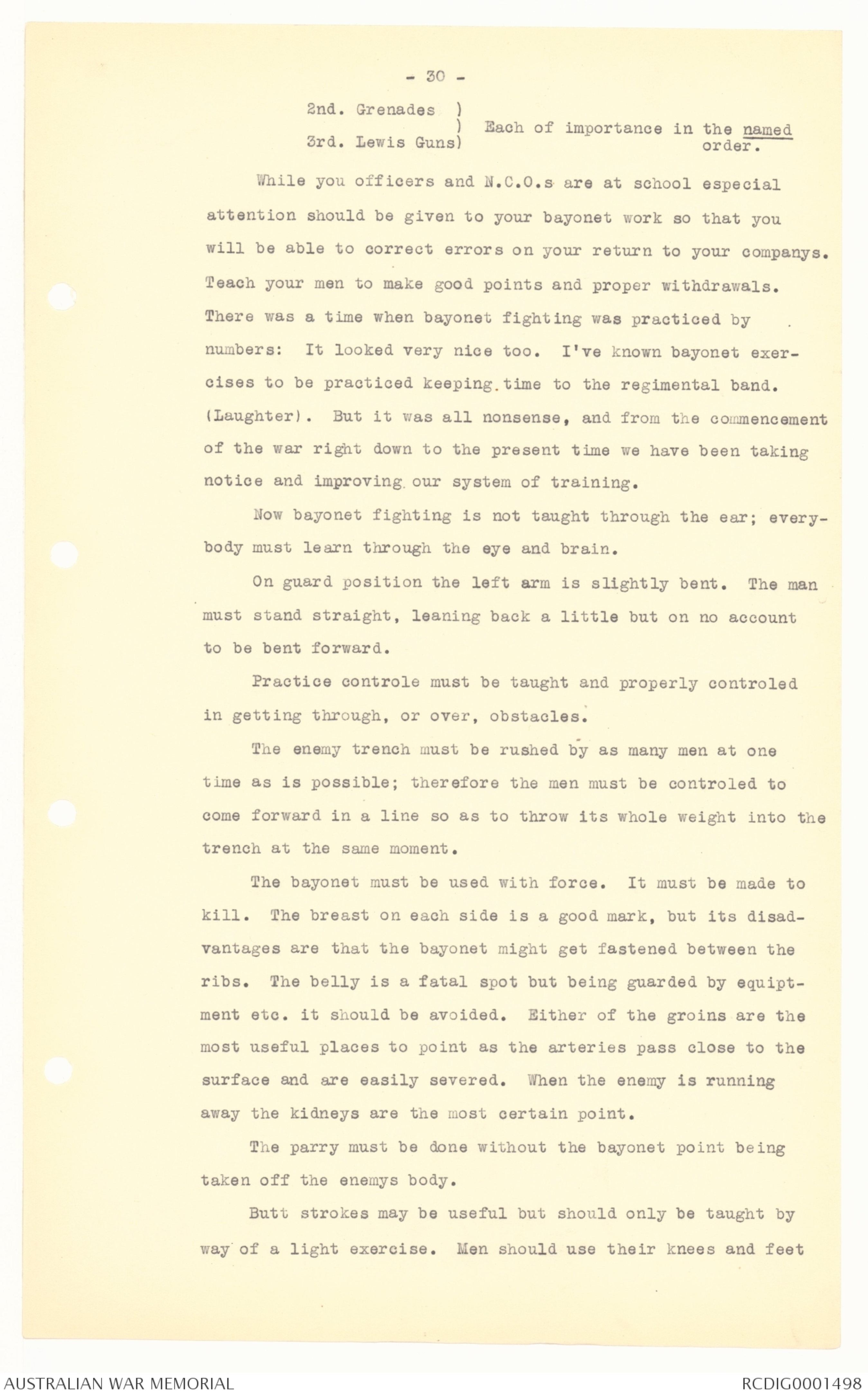
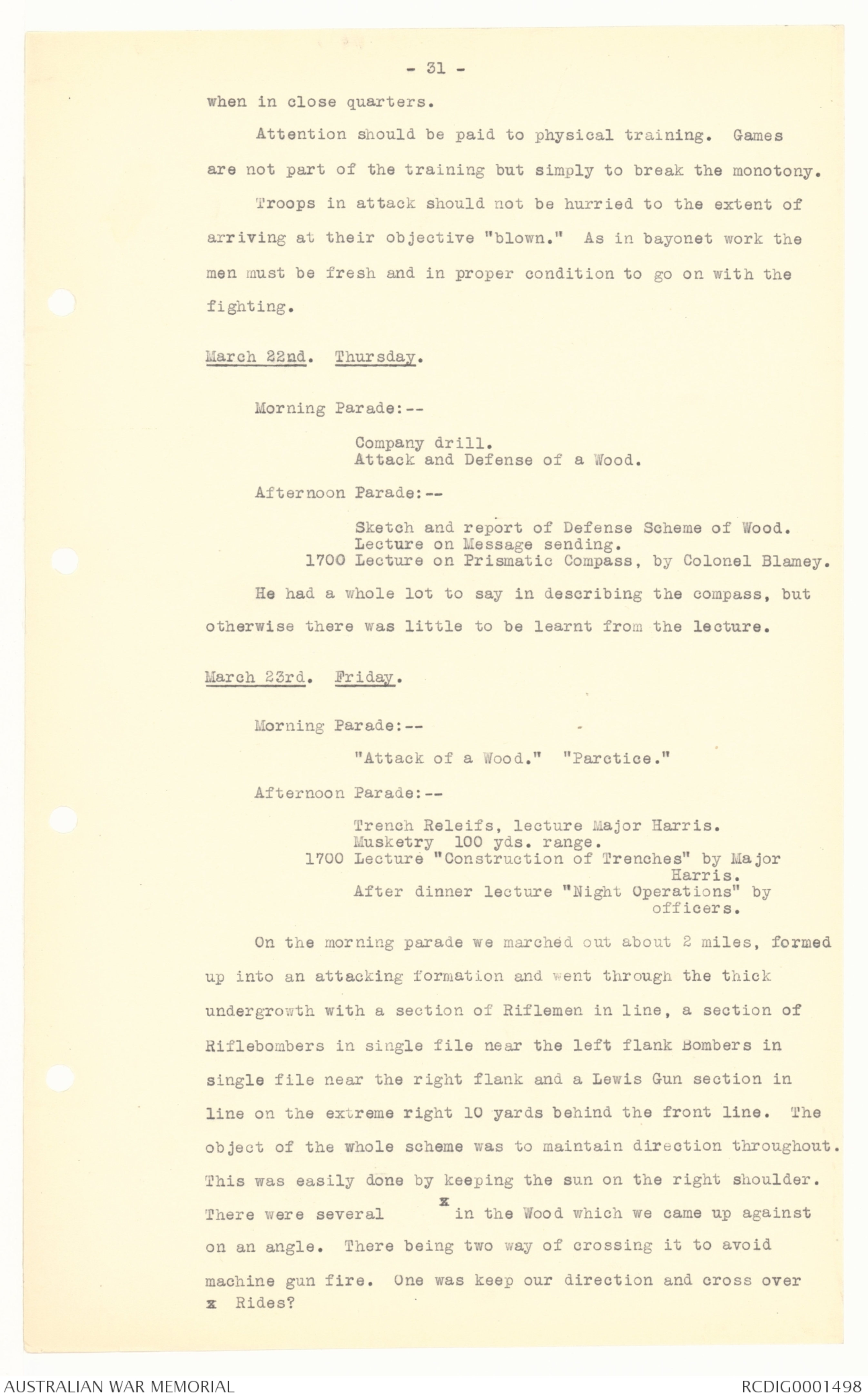
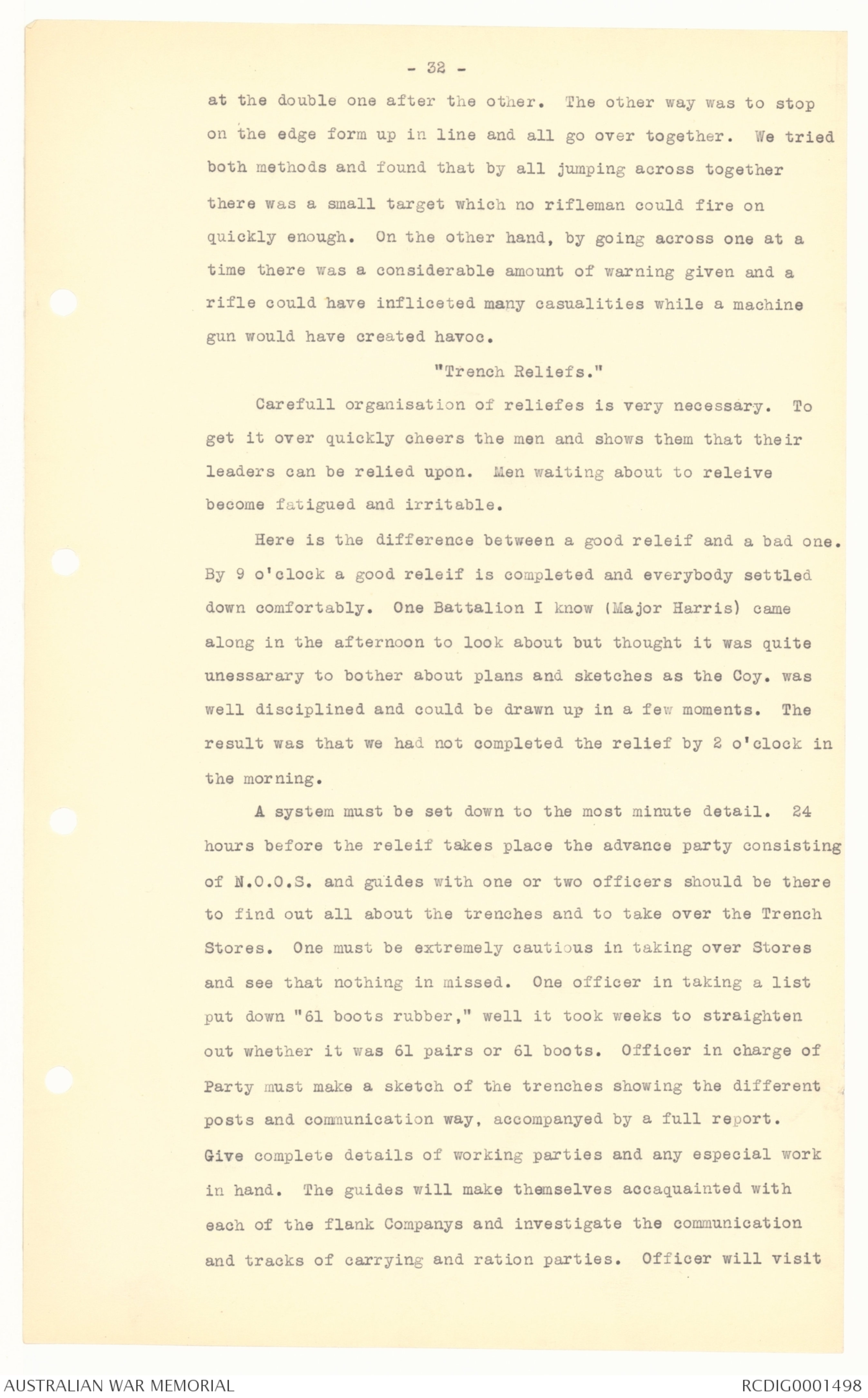
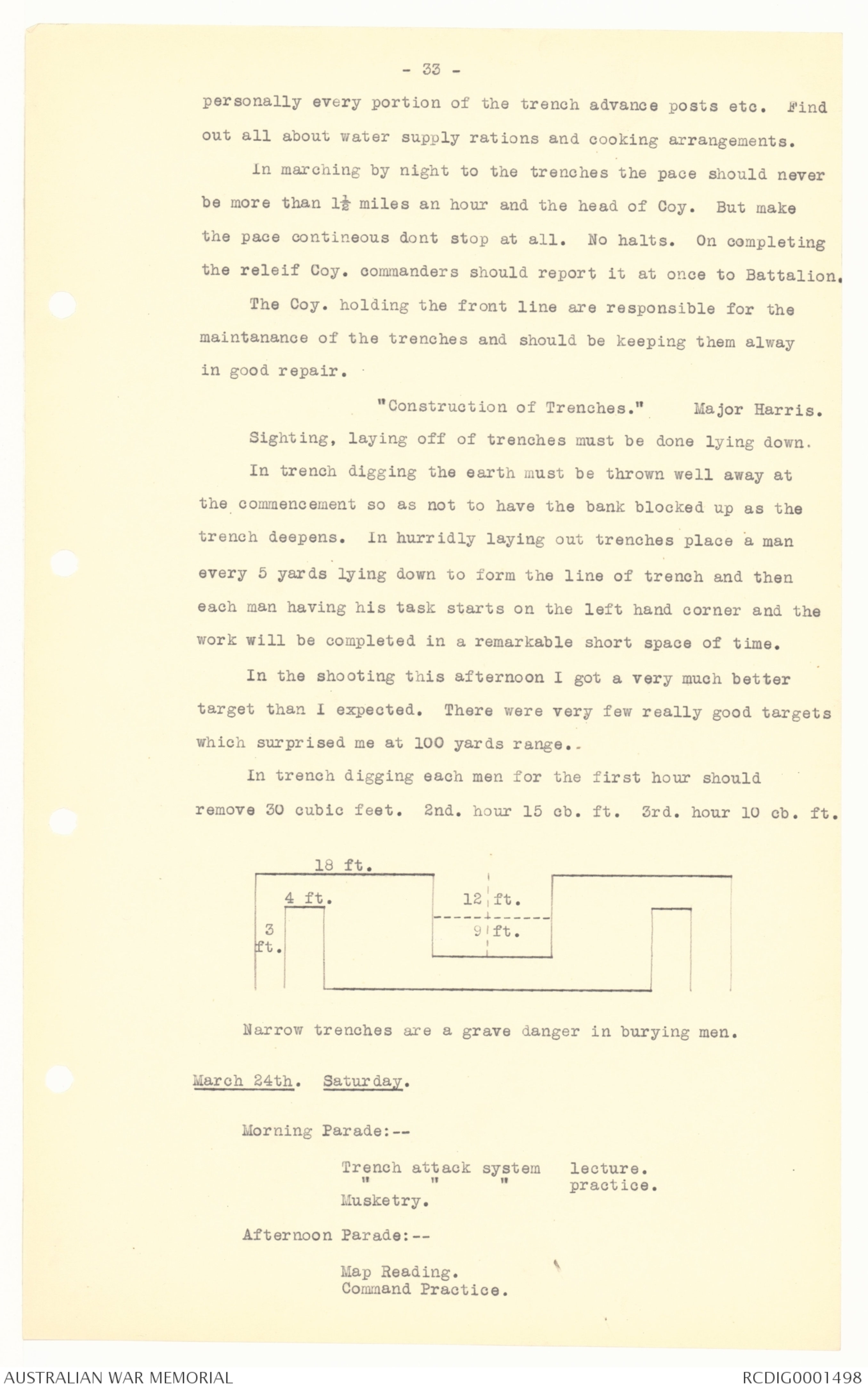
- 24 -
March 16th. Friday.
Morning Parade:--
Platoon drill.
Musketry 35 yd. range
Bombing.
Afternoon:--
Lewis gun.
Extended order drill.
5.30 Lecture German bombs.
7.00 Lecture by the Officers "Reconnessance".
Lecture by Capt. Maltby. "German Bombs."
There are 9 well know kinds of German hand grenades, and
2 kinds of rifle grenades.
"Stick grenade" weight 1 lb. 10 ozs. complete. There are
no bullets or pellets inside the tin can. It contains high
explosive only. The ignition is caused by friction on the
drawing of the string running down the centre of the wooden
handle.
"Cricket Ball" can be thrown 30 yds. The interior is
filled with gunpowder and on exploding by time fuse the castiron
casing breaks up and gives a shrapnel effect.
Egg grenades. 11 ozs. in weight.. German books say they
can be thrown 50 yards; but at the school here they have often
been thrown 65 yards and a good cricketer could throw them 90
yards. It contains a small gunpowder charge, and because of
its lightness and smallness is not to be feared much.
Oyster bomb, weight 13¼ to 15 ozs. It is a percussion
bomb only. Its flatness caused it to be thrown a long distance.
It is not a very destructive, being made of light plain iron
there is no metal to injure one. It is mostly used by men in
attack, as, when thrown edgewise there is no danger in coming
right up behind it, bursting right or left as it does.
Hairbrush bomb. It is a long can packed around the sides
with pellets, the centre containing the explosive. The bomb is
attached to a stick. It is one of the first bombs used by the
enemy, but are still being slightly used. Time or pecussion.
The rifle granades have a range of 400 yards. To reduce
the range a washer is placed firmly at the top of the iron rod
this has the effect of bringing the range down very much.
- 25 -
In extended order work there is the word retire to be
forgotten. In all infantry work the word retire should never
be used. It seems to throw the men into confusion when in a
fight. On the Somme front a German wounded shouted RETIRE,
and valuable ground was lost. It has caused much trouble on
other occasions also.
March 17th. Saturday.
Morning parade:--
Baths 2 hours.
Lewis Gun.
Afternoon parade:--
Physical T. and Bayonet fighting.
Section drill.
5.30 lecture on "Venearel Disease."
Dr. Appleyard after a few words on precautions against
veneral decided to postpone his lecture as he had no time to
complete it thoroughly. We were expecting to gain a lot of
information and advice to transmit to the men moreso as Major
Harris announced the lecture yesterday and laid especial stress
upon the great good it could do.
We have a new physical instructor, he rolled into us like
a whirlwind, and in bayonet work talked the spirit and religion
of the bayonet preaching blood, guts and ginger. He revelled
in his work and gave us a rough time. Talking the whole time
like a "cheap jack." He is however going to teach us a whole
lot of good stuff.
The Lewis Gun instructor mentions that there are three
stoppages only with a Lewis gun.
No. 1 stoppage:--Cocking H. in forward position.
(a) Empty space in magazine.
(b) Worn or broken feed paul and spring.
(c) Worn or broken stricker.
(d) Broken paul spring.
No. 2 stoppage:--C.H. over thumb piece on safety catch.
(a) Friction in gas chamber or working parts.
- 26 -
No. 3 stoppage:--C.H. behind front piece on safety catch.
Faults in feed due to breakage or weakness, or
faulty section of cartridge springs.
March 18th. Sunday.
Morning parade:--
1½ hours ceremonial drill.
Last Sunday we were instructed in taking Post on a
Battalion Parade. To-day it was Marching post a saluting base.
It is all very instructive and valuable.
March 19th. Monday.
Morning parade:--
Company drill.
Bayonet fighting.
Bombing in squads up a trench.
Afternoon parade:--
Reconnissance (report and sketch.)
Skirmishing.
Lecture "Grenades."
5 o'clock lecture on "Supply" by Major Milne D.S.O.
of A.S.C.
To-day is my turn as Orderley Officer. I seem to have
done my duties to satisfaction, though not with the confidence
with comes of knowledge and a soldierly bearing.
Company drill controled by Major Harris was a very good
lesson to me.
The report and sketch of a blank piece of country was a
difficult task and seemed to trouble all of the officers. Mine
attempt did not please me a bit but the time was very limited
and there was no strong features in the area for reconnissance
and report.
The lecture was a distinct failear that is as far as
learning anything new about "Mills grenades."
Major Milne seemed to have a nothing in the way of an
explaination to make showing that his Supply Department was a
marvelous organation and no shortage of ration could on any
- 27 -
account be traced home to his part in the business of getting
up the rations from the "Base" at Havre. He certainly showed
us that there were many difficulties surrounding the feeding
of so large a body of men. And explained away some indefinite
points. He gave the daily ration per man and told us that we
get this ration which is ridiculous. If the ration is not
issued it is due to stealing and negligence on the part of
the Q.M.
Daily Ration.
"As it leaves the Base."
Meat. 1 lb. fresh meat or 9 ozs. Bully ¾ tin per man.
60% of this ration is forwarded only per day, and
made up by Bully, Sardines, et.
Bread. 1 lb of bread or ¾ lb. of biscuits.
75% is drawn only 25% biscuits. This is the prevent
wastage in the event of large casualities.
Bacon. 4 ozs. daily.
Cheese. 3 " "
Jam. 3 " for 6 days, dried fruit one day.
Sugar. 3 ozs.
Milk 1/12 tin per man.
Vegetables. 2 ozs. dried or ½ lb. fresh.
Rum. 1/64th. gallon.
Butter. 2 ozs. 3 times week.
Salt. Pepper. Mustard. Pickles. Maches.
Tobacco and cigarettes 2 ozs. weekly.
Extra trench rations tea and sugar 2 ozs. soup.
Iron rations 1 tin bully tea sugar 1 lb. biscuits.
Especial stress was placed on the necessity for preserving
iron rations and holding onto them until the last possible
moment, particularly now that the lines of communication are
being lengthened.
March 20th. Tuesday.
Morning parade: --
Company drill.
- 28 -
Bayonet fighting.
Bombing (Live bombs.)
Afternoon Parade:--
Musketry. range finding.
Rapid Loading.
Platoon in attack.
After dinner lecture by officers on:-- Patroles.
1700 Lecture. WOOD AND VILLAGE FIGHTING.
Staff Major Smythe.
In defending a wood, they are different systems, according
to the the size of the wood, to be employed. High Wood, Bernafay
and Delville Woods are small ones. The German never defends
the front edge of a wood or the back edge either. The best way
seems to be by putting your strong line of trenches 150 or 200
yards in front and build support lines back 50 yds. or more
into the Wood. Digging of complete trenches will be extremely
difficult amongst the roots so a strong redoubt system is the
best way with tactacle barb wire amongst the trees to turn the
invaders onto the strong points.
Behind the Wood some 100 yards or more a reserve trench
should be placed, and from which counter attacks could be made.
The formation of the country will practically decide the
position in which trenches should be placed. Behind the crest
of a hill is a good place as it will be out of enemy observation.
In a wood lanes should be cut and undergrowth removed
and trees that are fallen should be done so as to fall towards
the enemy, they make good protection from observation and with
the branches wired an excellent barrier is made. Artillery
fire directed against a wood has a serious tendency to knock
down trees and block the whole wood up with fallen timber.
In attacking a wood the defender is mostly very nervous
concerning his flanks being out of his touch and in the open.
Always move your men across open country in open line, and in
"Close" country keep them in close formation. But when moving a
body of men always keep them under your direct command in close
column as long as it is possible: Heavy shell fire will be the
only reason for applying open or artillery formation.
In "screening" an attack upon a wood have the "screen"
- 29 -
of men close enough to see one another.
In getting onto the other side of the wood always move
carefully as there is sure to be an enemy trench covering the
fringe of the wood. Advance through undergrowth firing freely.
Snipers may be in trees; at anyrate by firing freely the
enemy becomes upset and likely to over-rate the advancing partys
strength.
Men always have a tendency to bunch together: try and
avoid this.
Villages are usually taken into the general line of defense
as there is good protection for the men, good positions
for observating purposes and also a good water supply.
If the Village is smashed by gun fire the attack will be in
waves as on the average line of trenches.
The "Leap-froge" system of advancing will be employed
through villages. Choose flanking methods of attacking a
village if possible.
Men should be spread out over open country when being
shelled. Shrapnel throws forward 200 yds. and lateral range,
25 yards. If you hurry your men try and give them a rest in
a sheltered place before attack.
March 21st. Wednesday.
Morning Parade:--
New attacking formation lecture.
" " " practice.
Afternoon Parade:--
Rugby football match. Officers V. N.C.O.s.
One try each.
1700 Lecture. BAYONET FIGHTING by Capt. Hood.
Army Instructional Staff.
"It has been a very great surprise to me to actually see
for myself what little some of the 1st. Aust. Division know
about bayonet fighting; their attempt at both the "long point"
and the withdrawal are bad.
An infantry unit has at its command three weapons.
1st. Rifle and bayonet)
- 30 -
2nd. Grenades )
) Each of importance in the named order.
3rd. Lewis Guns)
While you officers and N.C.O.s are at school especial
attention should be given to your bayonet work so that you
will be able to correct errors on your return to your companys.
Teach your men to make good points and proper withdrawals.
There was a time when bayonet fighting was practiced by
numbers: It looked very nice too. I've known bayonet exercises
to be practiced keeping time to the regimental band.
(Laughter). But it was all nonsense, and from the commencement
of the war right down to the present time we have been taking
notice and improving our system of training.
Now bayonet fighting is not taught through the ear; everybody
must learn through the eye and brain.
On guard position the left arm is slightly bent. The man
must stand straight, leaning back a little but on no account
to be bent forward.
Practice controle must be taught and properly controled
in getting through, or over, obstacles.
The enemy trench must be rushed by as many men at one
time as is possible; therefore the men must be controled to
come forward in a line so as to throw its whole weight into the
trench at the same moment.
The bayonet must be used with force. It must be made to
kill. The breast on each side is a good mark, but its disadvantages
are that the bayonet might get fastened between the
ribs. The belly is a fatal spot but being guarded by equiptment
etc. it should be avoided. Either of the groins are the
most useful places to point as the arteries pass close to the
surface and are easily severed. When the enemy is running
away the kidneys are the most certain point.
The parry must be done without the bayonet point being
taken off the enemys body.
Butt strokes may be useful but should only be taught by
way of a light exercise. Men should use their knees and feet
- 31 -
when in close quarters.
Attention should be paid to physical training. Games
are not part of the training but simply to break the monotony.
Troops in attack should not be hurried to the extent of
arriving at their objective "blown." As in bayonet work the
troops must be fresh and in proper condition to go on with the
fighting.
March 22nd. Thursday.
Morning Parade:--
Company drill.
Attack and Defense of a Wood.
Afternoon Parade:--
Sketch and report of Defense Scheme of Wood.
Lecture on Message sending.
1700 Lecture on Prismatic Compass, by Colonel Blamey.
He had a whole lot to say in describing the compass, but
otherwise there was little to be learnt from the lecture.
March 23rd. Friday.
Morning Parade:--
"Attack of a Wood." "Parctice."
Afternoon Parade:--
Trench Releifs, lecture Major Harris.
Musketry 100 yds. range.
1700 Lecture "Construction of Trenches" by Major
Harris.
After dinner lecture "Night Operations" by
officers.
On the morning parade we marched out about 2 miles, formed
up into an attacking formation and went through the thick
undergrowth with a section of Riflemen in line, a section of
Riflebombers in single file near the left flank Bombers in
single file near the right flank and a Lewis Gun section in
line on the extreme right 10 yards behind the front line. The
object of the whole scheme was to maintain direction throughout.
This was easily done by keeping the sun on the right shoulder.
There were several x in the Wood which we came up against
on an angle. There being two way of crossing it to avoid
machine gun fire. One was keep our direction and cross over
x Rides?
- 32 -
at the double one after the other. The other way was to stop
on the edge form up in line and all go over together. We tried
both methods and found that by all jumping across together
there was a small target which no rifleman could fire on
quickly enough. On the other hand, by going across one at a
time there was a considerable amount of warning given and a
rifle could have infliceted many casualities while a machine
gun would have created havoc.
"Trench Reliefs."
Carefull organisation of reliefes is very necessary. To
get it over quickly cheers the men and shows them that their
leaders can be relied upon. Men waiting about to releive
become fatigued and irritable.
Here is the difference between a good releif and a bad one.
By 9 o'clock a good releif is completed and everybody settled
down comfortably. One Battalion I know (Major Harris) came
along in the afternoon to look about but thought it was quite
unessarary to bother about plans and sketches as the Coy. was
well disciplined and could be drawn up in a few moments. The
result was that we had not completed the relief by 2 o'clock in
the morning.
A system must be set down to the most minute detail. 24
hours before the releif takes place the advance party consisting
of N.O.O.S. and guides with one or two officers should be there
to find out all about the trenches and to take over the Trench
Stores. One must be extremely cautious in taking over Stores
and see that nothing in missed. One officer in taking a list
put down "61 boots rubber," well it took weeks to straighten
out whether it was 61 pairs or 61 boots. Officer in charge of
Party must make a sketch of the trenches showing the different
posts and communication way, accompanyed by a full report.
Give complete details of working parties and any especial work
in hand. The guides will make themselves accaquainted with
each of the flank Companys and investigate the communication
and tracks of carrying and ration parties. Officer will visit
- 33 -
personally every portion of the trench advance posts etc. Find
out all about water supply rations and cooking arrangements.
In marching by night to the trenches the pace should never
be more that 1½ miles an hour and the head of Coy. But make
the pace contineous dont stop at all. No halts. On completing
the releif Coy. commanders should report it at once to Battalion.
The Coy. holding the front line are responsible for the
maintenance of the trenches and should be keeping them alway
in good repair.
"Construction of Trenches." Major Harris.
Sighting, laying off of trenches must be done lying down.
In trench digging the earth must be thrown well away at
the commencement so as not to have the bank blocked up as the
trench deepens. In hurridly laying out trenches place a man
every 5 yards lying down to form the line of the trench and then
each man having his task starts on the left hand corner and the
work will be completed in a remarkable short space of time.
In the shooting this afternoon I got a much better
target than I expected. There were very few really good targets
which surprised me at 100 yards range.
In trench digging each men for the first hour should
remove 30 cubic feet. 2nd. hour 15 cb. ft. 3rd. hour 10 cb. ft.
Hand drawn diagram - see original document
Narrow trenches are a grave danger in burying men.
March 24th. Saturday.
Morning Parade:--
Trench attack system lecture.
" " " practice.
Musketry.
Afternoon Parade:--
Map Reading.
Command Practice.
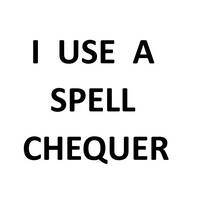 Not Yet Replaced By AI
Not Yet Replaced By AIThis transcription item is now locked to you for editing. To release the lock either Save your changes or Cancel.
This lock will be automatically released after 60 minutes of inactivity.